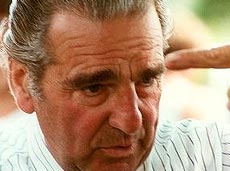
John Cooper
awarded a CBE for services to the
motor industry in 1999
|
A
Legend in the Making
Since his birth in 1923 John Cooper grew
up surrounded by cars. His father Charles
ran a small garage and also worked as
a mechanic for land-speed record driver
Kaye Don. After leaving school at 15 to
become a toolmaker, John went on to tool
instruments in the RAF. When John was
in his mid twenties he left the RAF and
with his father formed the Cooper Car
Company as he was determined to race cars.
In the late 1940's John and his father
built their prototype Cooper 500 - a cigar
shaped single seater with a mid mounted
engine, one of the first of it's type.
John teamed up with old friend Eric Brandon
and raced the 500's. It was extremely
successful and was quickly snapped up
by the private racing teams and their
drivers, including Sterling Moss. The
Cooper Car Company boomed and the success
led into new developments in the early
50's. The front engined Cooper Bristol
F2 was born. This too was a success and
was driven by the greats, including Fangio.
A new layout resulted in a rear engined
Formula 2 car, of which a special version
was built for Jack Brabham, who drove
it to 6th place in the 1957 Monaco Grand
Prix. It's lightweight construction and
sharp handling was starting to challenge
the big boys like Ferrari and Maserati.
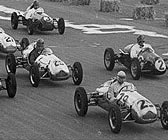
Rear-engined Cooper 500's
|
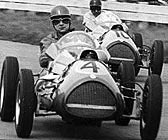
Front-engined Cooper Bristol
|
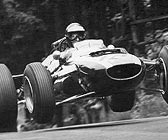
Rear-engined Formula 2
|
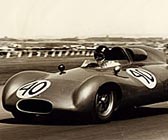
Coopers dominated F1
|
In
1958, the Cooper Car Company started to
fill the trophy cabinet. Stirling Moss
drove Rob Walker's F2 T43 Cooper to victory
at the Argentinian Grand Prix - it was
the first ever rear engined car to win
a GP. Later that year another of Rob Walker's
Cooper won the Monaco GP. In '59 and '60
the Cooper Car Company won both drivers
and constructors titles. This led to competing
at Indianapolis where the Americans thought
it very odd that the engine was in the
rear - in the wrong place to them. The
Coopers didn't win due to tyre problems,
but a year later all F1 cars followed
the Coopers lead and were rear engined.
Coopers dominated Formula 1, 2 and 3.
Young talents like Jackie Stewart drove
the Cooper F3 BMC car, which ironically
shared the A series powerplant that ended
up in the Mini.

Birth
of the Mini Cooper
Formula racing was beginning to be dominated
by the big companies, they bankrolled
new technology that the Coopers couldn't
keep up with, so they turned their attention
to rallying and road racing. John had
driven the Mini and liked the pin sharp
handling and low weight, so the Mini Cooper
was born.
John Cooper persuaded the Mini's creator,
Sir Alec Issigonis, to let him produce
a high-performance version of the car
even though Sir Alec did not believe it
would sell.
In 1961 the first Mini Cooper hit the
streets and was an immediate success,
firstly with a 997cc engine producing
a massive 55bhp. Then followed the rare
970cc Cooper S and in 1963 the superior
1275cc S which pumped out 76bhp, which
was an even bigger hit on the streets.
It was this model which would form the
basis for the Works Rally car. The Cooper
S achieved legendary status when the 91bhp
Cooper Works cars won the Monte Carlo
Rally outright for 4 years running from
1964-1967 (although the Minis were disqualified
from the 1966 rally for having faulty
headlamps!) Even the British Saloon Car
Championship circuits were dominated by
the Coopers, winning races left, right
and centre. The Mini Cooper was now an
icon and everybody wanted a Cooper. The
good and great of the 60's had Coopers,
including Paul McCartney, Graham Hill
and Enzo Ferrari!
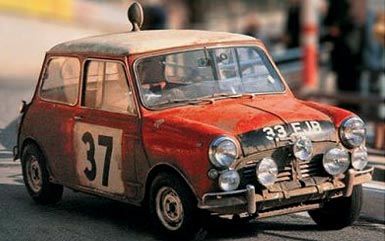
Paddy
Hopkirk's Cooper drives to glory at the
'64 Monte Carlo Rally
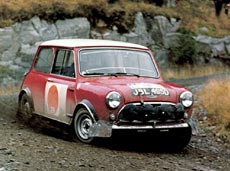
'66 RAC Rally |
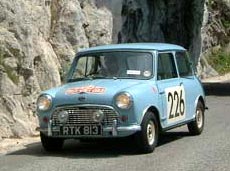
Another Cooper
tackles Monte Carlo |
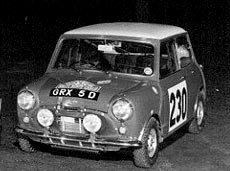
'66 Monte
Carlo Winner - but disqualified |
A
wolf in sheep’s clothing: The creation
of the Mini Cooper
Long
before Alec Issigonis drew his legendary
sketches of the Mini, he became a good
friend of one of the leading constructors
of racing cars at the time: John Cooper.
Cooper used Morris engines in his Formula
Junior racing cars and was therefore a
much-appreciated specialist acknowledged
by Issigonis as the right man for discussing
engine concepts. So John Cooper was deeply
involved in the process of developing
the Mini right from the start.
With the Mini gradually becoming reality,
Cooper was confident that this new car
set to enter the market was exactly what
he had been looking for for a long time:
the foundation for a sports car able to
compete with the Lotus Elite. Cooper had
already tried to challenge the Elite with
a Renault Dauphine powered by a Coventry
Climax engine, but was far from happy
with the car’s handling. So as soon
as he got his hands on this new small
athlete, he started preparing the car
for racing, taking an original Mini Cooper
to the 1959 Italian Grand Prix in Monza
together with his driver, Roy Salvadori.
From the start, their journey to Monza
developed into a race with Reg Parnell,
another famous racing driver, who was
travelling to Italy in his Aston Martin
DB4. At the finish line Cooper’s
new Mini was a whole hour faster and Cooper
was more than convinced that the Mini
had all the potential he had been hoping
for.
Starting
out with 1,000 Mini Coopers
Cooper then approached Issigonis with
the proposal to develop a small GT out
of the Mini. But Issigonis, as before,
saw the car as a 'people’s car for
everybody' and turned down the suggestion.
Not letting go, however, John Cooper contacted
George Harriman, the Chief Executive of
BMC, directly. BMC or, to use the full
name, British Motor Corporation, had been
formed in 1952 by he merger of various
British car makers, comprising, among
others, the Austin, Morris, MG and Wolseley
brands. And Harriman was convinced of
Cooper’s idea, agreeing to build
a small series of 1,000 Mini Coopers in
order to test public response.
With the engine not supposed to displace
more than one litre, Cooper set off by
increasing stroke from 68.3 mm (2.69´´)
to 81.3 mm (3.20´´) and reducing
engine bore from 62.9 mm (2.48´´)
to 62.4 mm (2.46´´), spreading
out these dimensions on four cylinders
to provide cubic capacity of exactly 997
cc. Compression was increased from 8.3
to 9.0, and larger intake valves as well
as double carburettors were added as further
features. Additional modifications were
the larger outlet opening and a reinforced
crankcase designed to cope with the extra
power of the engine. Cooper also modified
the gear ratios in the interest of higher
top speed, engine output increasing to
55 bhp and top speed to approximately
130 km/h or 81 mph. To add the right brakes
for this extra power, Cooper finally fitted
7-inch Lockheed disc brakes on the front
wheels.
Many motorsport enthusiasts were thrilled
by this new concept and a long series
of successful entries in motor racing
convinced BMC that this was the right
car for the future.
A power unit built for success: 1,071
cubic centimetres, 70 bhp. Now Issigonis
also changed his mind, joining forces
with John Cooper to boost engine output
to an even higher level. The concept applied
for this purpose had already proven its
merits in John Cooper’s Formula
Junior power unit: small engine stroke
with a large bore, combined with reinforced
bolts for the cylinder head. Proceeding
from this concept, the engineers choose
the 848-cc power unit as the basic engine
for the Cooper S. With stroke remaining
unchanged at 68.2 millimetres or 2.69´´,
bore was increased to 70.6 millimetres
or 2.78´´, thus reaching the
absolute limit. This enabled John Cooper
to achieve two important targets at the
same time, engine displacement, at 1,071
cc, remaining below the 1,100-cc limit
applied in the racing class envisaged,
whilst the short stroke allowed the engine
to rev reliably and smoothly at high speeds.
Accordingly, maximum output was 70 bhp
at 6,200 rpm and maximum engine speed
an even more impressive 7,200 rpm.
Clearly, this extra power also meant a
higher top speed requiring John Cooper
to take a look at the brakes, too: Brake
disc diameter was increased to 7½
inches, and brake power was now boosted
by a servo. Introducing disc brakes, Cooper
also opened up the door for Lockheed to
enter a new market. So far disc brakes
had been featured only on much larger
and more expensive cars, but were now
able, thanks to the success of the Mini
Cooper, to move down into lower market
segments.
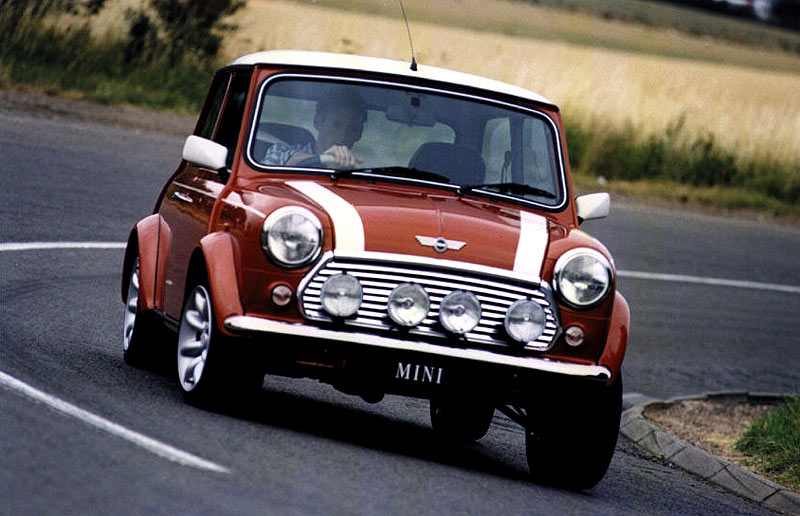
1997
Rover Mini Cooper with sports pack
Ten years of production with a 19-year
break in between: the return of the Mini
Cooper
The
Mini Cooper was built to these –
or similar – specifications for
exactly 10 years, from July 1961 to July
1971. But then Lord Stokes stopped production.
Worldwide demand nevertheless remained
substantial, inducing John Cooper to build
tuning kits of great popularity particularly
in Japan. Assuming responsibility for
the Mini for a number of years, Rover
Group requested Cooper to sell these kits
also in their home market, where they
likewise became a great success. Recognising
this market opportunity, Rover brought
back the Mini Cooper in 1990, various
versions of the car being built once again
in Longbridge up to the end of Mini production.
John Cooper Garages, going even further,
built a number of limited editions based
on the Mini Cooper S, such as the Grand
Prix, Sport 5, Cooper S touring, and the
90-horsepower version. And naturally there
are also the John Cooper Tuning Kits available.
In addition, it produced bespoke specials
for it's most enthusiastic customers,
while continuing to offer its expert engine
tuning service for its conversion kits.
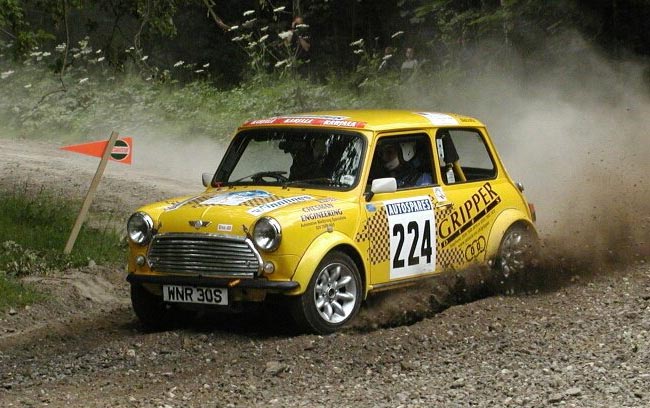
Trevor
Godwin / Ian Harrop pilot their Rover
Mini Cooper at the Dukeries Rally
End of an Era
After 137 versions and 41 years the final
Mini, chassis no. 5,387,862 rolled off
the production line at Longbridge on Wednesday
4th October 2000. Accompanied by strains
of the 'Self-preservation Society' the
red Mini Cooper S was driven off the production
line by 60's icon Lulu.
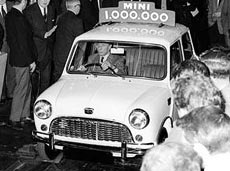
Issigonis
drives 1 millionth in '65 |
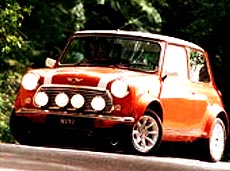
90 bhp Cooper
S Works |
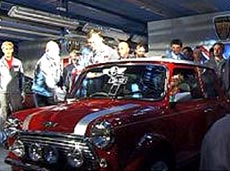
Last ever
Classic Mini (Cooper S) |
New
MINI Cooper
During the mid to late 1990's, john Cooper
Garages was invited to contribute it's
expertise to BMW Group's new MINI project.
the company formed a team that would commence
work on the design and production of engine
and chassis enhancement kits for the new
MINI Cooper. John was delighted when his
son Michael was asked to put the new prototype
MINI Cooper through it's paces.
On Sunday 24th December 2000 John sadly
passed away, aged 77, signaling the end
of an era, but his boundless talent, energy
and enthusiasm meant that he presided
over the birth of a new one. With the
advent of the John Cooper Works in a newly
converted premises, an exciting new car
adventure was about to begin. By 2002
John Cooper Works launched approved tuning
kits for the new MINI Cooper. Mike Coopers
plans to get the Cooper name back into
racing became a reality when the John
Cooper Challenge was introduced in the
UK. A multi discipline race series designed
to give drivers everyday road use and
racing at the weekends from the same vehicle.
the series instantly sold out.
By 2003 MINI gave John Cooper Works full
approval to produce tuning kits for MINI
Cooper and Cooper S. The John Cooper Works
Tuning Kits are available from John Cooper
Works and MINI dealerships worldwide.
John Cooper Works competed in the Nürburgring
24 Hour Race with the first 'Works' entry
since 1967.

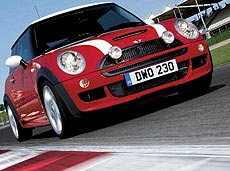
MINI Cooper
S Works |
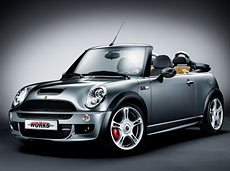
MINI Cooper
S Works Cabriolet |
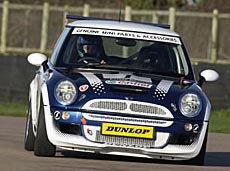
S Works at
Nürburgring
24 Hour Race |
|